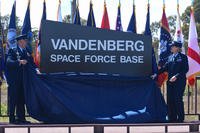As part of the Defense Department's ongoing efforts to maintain assured, affordable access to space through 2030, the Atlas V rocket successfully lifted off from Space Launch Complex-41 at Florida's Cape Canaveral on June 20, Air Force officials said.
"This is an exciting time for the U.S. space launch community, said Scott Correll, the program's executive officer. "From today's successful launch of the 50th Evolved Expendable Launch Vehicle to the recent success of Space X's support to NASA with their Falcon 9, it's clear the commercial space transportation industry is making notable strides."
The EELV program replaced the existing fleet of launch systems with two families of launch vehicles -- the Boeing Delta IV and Lockheed Martin Atlas V -- built and operated by the DOD's prime contractor, United Launch Alliance, Correll said.
An official from the Space and Missile Systems Center at Los Angeles Air Force Base, Calif., explained that the Atlas V is a critical part of a spectrum of government missions.
"Atlas V launches space-based infrared systems, global positioning systems, the defense meteorological satellite program and the advanced extremely high frequency system satellites," said Col. Bob Hodgkiss, the director of the launch systems directorate. "I'm pleased to report that this year we have also already launched the wideband global sat-com IV aboard a Delta IV, and the Navy's mobile user objective system satellite 1 aboard Atlas V."
Because of considerable program costs, which can run as high as several billion dollars per launch, quality assurance and the development of a competitive market are paramount, Air Force officials said.
"Since the Air Force must by law self-indemnify, we do a very rigorous evaluation of the physical, electrical and radio frequency interfaces between the rocket, the satellite and the ground systems," Hodgkiss said of the process to determine flight readiness. "My team is the government's insurance policy, so we need to be sure we have the highest probability of success in one of the riskiest activities the Air Force does."
On the business side of the program, Hodgkiss said, the program's primary users, the Air Force, NASA and the National Reconnaissance Office, are developing strategies to infuse competition into space launch as a cost reduction measure.
"We are balancing the commitment we will make to ULA with the potential to reintroduce competition to the program when one or more commercial launch companies have demonstrated to the Air Force they are reliable launch providers," the colonel said.
Correll asserts that certifying new entrants will potentially enable competition, thereby lowering costs and creating innovation in government payloads such as communications, navigation, weather satellites, and science and national security missions.
"The framework offers multiple paths to on-ramp potential new entrants and part of this strategy requires an entrant to demonstrate at least one launch of a vehicle configured as an EELV-class national security space launch," he said.
ULA's next launch and the NRO's next mission, the Delta IV NROL-15, is scheduled for June 28.
"Our Soldiers, Sailors, Marines, Airmen, Coast Guardsmen and intelligence community are dependent upon the warfighting capabilities we enable," Correll said. "Our priority and focus remain mission success first while controlling costs in this constrained fiduciary environment."

























